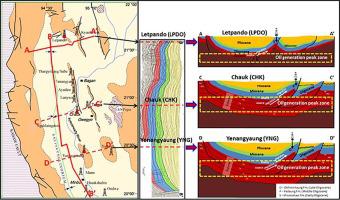Journal of Asian Earth Sciences ( IF 3 ) Pub Date : 2021-08-02 , DOI: 10.1016/j.jseaes.2021.104905 Sai Naing Lin Aung 1, 2 , Sheng He 1 , Ei Mon Han 3 , Yoshikazu Sampei 4 , Tian Dong 1 , May Thu Thu Aung 1, 2

|
Fourteen crude oil samples were collected from the South (Yenangyaung: YNG), Central (Chauk: CHK), and North (Letpando: LPDO) oilfields in the Salin sub-basin, Myanmar. This study investigated the organic geochemical characterization of crude oils from early to late Oligocene reservoir rocks. The saturated and aromatic hydrocarbons of selected oil samples were analyzed by integration of gas chromatography and gas chromatography-mass spectrometry methods to evaluate their origin, depositional environment, and thermal maturity. All the oils have moderate to high API gravity, showing medium to light oils. Crude oils were classified into three groups based on their biomarker compositions. The group I oils (Okhmintaung Formation, upper Oligocene, YNG Oil Field) mainly originated from planktons/algal materials with less contribution of terrestrial input, deposited under sub-oxic environments (lacustrine-marine setting). The group II oils (Padaung Formation, middle Oligocene, CHK Oil Field) were significantly generated from planktons/algal sources with minor input from terrestrial materials, deposited in an oxic/sub-oxic environment (fluvial/deltaic-marine setting). Group III oils (Shwezettaw Formation, lower Oligocene, LPDO Oil Field) were derived from a mixed contribution of planktons/algal materials and terrestrial input accumulated under an oxic environment (fluvial/deltaic-marine setting). Group I and Group II oils have reached peak oil window, while Group III oils indicate the early oil window. The results of stable carbon isotopic compositions for all analyzed oil samples indicate that the source rocks were derived from marine algae, and terrestrial and/or freshwater algal materials. Oil-oil correlation suggested that Oil Groups exhibit mixed source characterization during hydrocarbon accumulation processes.
中文翻译:

缅甸萨林盆地渐新统油藏原油的有机地球化学:对来源、成熟度和沉积环境的洞察
从缅甸萨林次盆地的南部(Yenangyaung:YNG)、中部(Chauk:CHK)和北部(Letpando:LPDO)油田采集了 14 个原油样品。本研究调查了早到晚渐新世储集岩原油的有机地球化学特征。结合气相色谱法和气相色谱-质谱法对选定油样的饱和烃和芳烃进行分析,以评估其来源、沉积环境和热成熟度。所有的油都具有中到高的 API 比重,显示出中到轻的油。原油根据其生物标志物组成分为三组。I组油(Okhmintaung组,渐新统上层,YNG油田)主要来源于浮游生物/藻类物质,陆地输入贡献较小,沉积在亚氧环境下(湖-海环境)。II 组油(Padaung 组、中渐新世、CHK 油田)主要来自浮游生物/藻类来源,少量来自陆地材料,沉积在有氧/亚氧环境(河流/三角洲-海洋环境)中。第 III 组油(Shwezettaw 组、下渐新世、LPDO 油田)来自浮游生物/藻类物质和在有氧环境(河流/三角洲-海洋环境)下积累的陆地输入的混合贡献。I 组和 II 组油已达到峰值油窗,而 III 组油指示早期油窗。所有分析的油样的稳定碳同位素组成结果表明,烃源岩来自海藻、陆地和/或淡水藻类材料。



























 京公网安备 11010802027423号
京公网安备 11010802027423号